Utah Beach M4A1(76)W HVSS Sherman Tank
This version of Sherman tank is known as the Easy Eight. It is outside the Utah Beach Memorial Museum and looks impressive. There is a problem. The museum is about the D-Day landings in Normandy on 6th June 1944. The M4A1E8(76) HVSS Sherman Tank 'Easy Eight' only arrived in Europe in December 1944 just in time for the Battle of the Bulge.
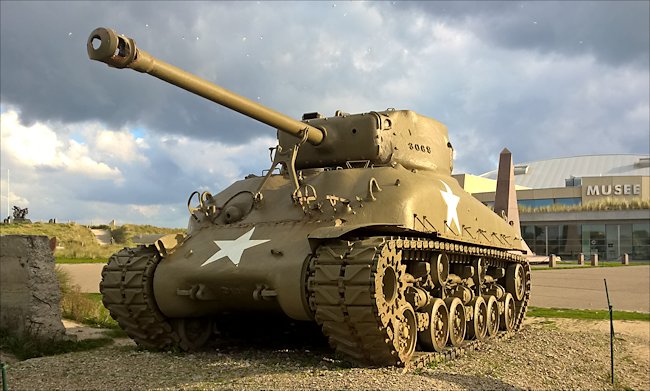
M4A1(76)W HVSS Sherman tank outside the Utah Beach Memorial Museum
Location
Outside the Utah Beach Memorial Museum is a M4A1(76)W HVSS Sherman an 'Easy Eight'. It is on the D421 coast road near the junction with the D913. It is problematic to locate using some Sat-Nav systems as there are no large towns near to the museum.
If you set your Sat-Nav to Sainte-Marie-du-Mont and the Rue du General Eisenhower, that is the D913. If you head north east out of town that will take you to Utah Beach and the Museum.
Specification
The M4A1(76)W was also known as the M4A1E8 (Easy Eight). The tank was fitted with the long barreled high velocity 76mm M1 gun. The tank had a 30-60 Browning M1919A4 machine gun on the left of the main gun and one in a ball mount in the hull. What made this tank different to other Shermans was the width of the tracks. They were 23 inches wide rather than the normal 16 inch width. This gave the tank the ability to cross wet muddy ground without sinking. They were also fitted with new Horizontal Volute Suspension (HVSS)
The tank was powered by a Continental R975 C1 9 cylinder radial petrol engine that produced 400 hp. The tank had a top road speed of 25 mph (40 km/h). It had an operational range of 120 miles (193 km) before needing to be refueled. The five man tank crew included the commander, driver, gunner, loader and co-driver/hull machine gunner.
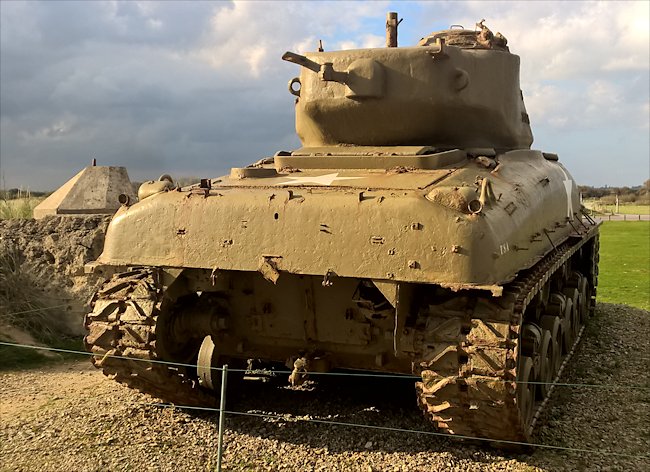
was also known as the Sherman tank had extra wide 23 inch tracks instead of the normal 16 inch tracks.
Tank Landings on Omaha Beach
On D-Day 6th June 1944 sea conditions were rough. Sherman tanks fitted with the Duplex Drive (DD) and waterproof canvas skirts were not designed to swim through rough seas with high waves. only two of the 32 DD Sherman tanks belonging to the US 741st Tank Battalion reached Omaha Beach. Most of the others were swamped by waves coming over the top of the canvas skirt floating device.
Many men were trapped in their tanks by the collapsing canvas and the weight of the water above them. They drowned. Records show 27 of these DD tanks sank before they reached Omaha Beach. The two that landed on the beach were joined my three more that could not launch into the sea as the ramp on their LCT landing craft was damaged. The LCT took them straight into the beach where they managed to get off the boat.
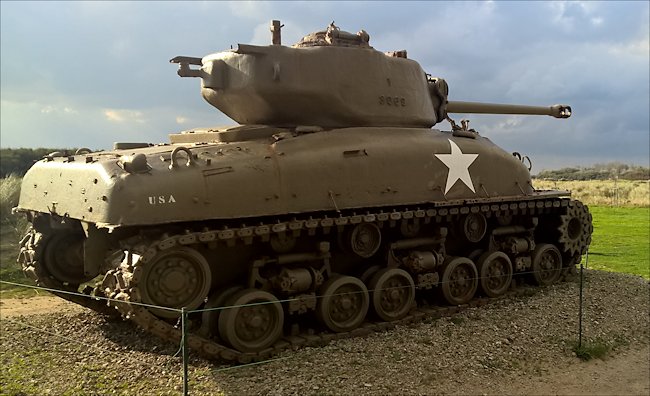
The M4A1(76)W HVSS Sherman tank's 76mm long barreled high velocity gun was fitted with a muzzle brake to help reduce recoil and stresses on the gun barrel.
The US 743rd Tank Battalion was also issued with 32 DD Sherman Tanks. Luckily none of these tanks were launched into the sea after seeing the disaster that hit the US 741st Tank Battalion DD tanks. They all landed directly onto the beach, under fire, at 6.40am. Nine of these tanks were knocked out in the fighting on D-Day. There were 23 left at the end of the day to carry on fighting.
The landing craft carrying the doomed DD tanks of the US 741st Tank Battalion where having difficulty keeping on course because of the strong sea currents. They started to drift away from the target beach. When the tanks were launched 5,000 yards away from the beach, they had to fight the sea current to aim for their section of Omaha Beach.
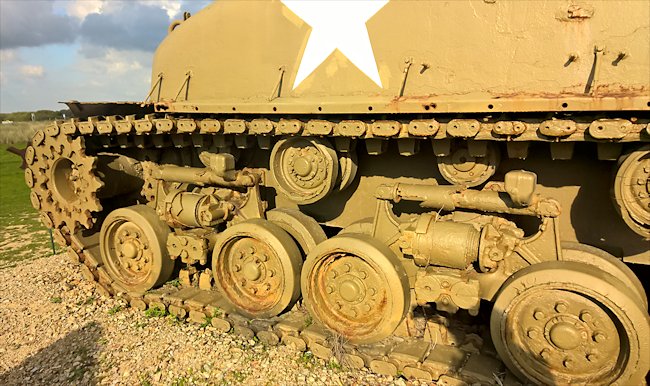
M4A1(76)W HVSS Sherman tank was fitted with improved HVSS suspension.
This meant that they were forced to go side on to the high waves which was fatal. These big waves crashed over the canvas skirts and crumpled them. The story goes that the two tanks that made it to the beach were commanded by men who in peacetime had done a lot of sailing and knew not to go side on to big waves unlike the others.
Not all the tanks that sunk to the sea bed sank as soon as they left the landing craft. Many of the tank wrecks are still on the bottom of the sea. They have been mapped and it has been found that some got as close as 1,000 metres. Some of the sinking tanks had time to radio back what was happening and not to launch so far out to sea. This quick thinking saved lives.
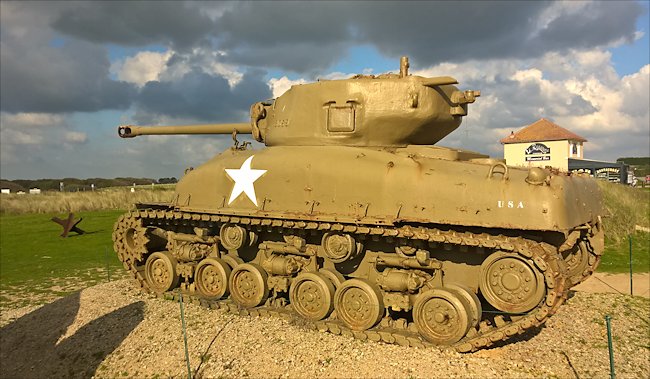
All M4A1(76)W HVSS Sherman tanks had a larger extended turret to carry the bigger 76mm gun.
Some critics of the tactics of using DD tanks have said that they should not have been used and tanks should have been landed directly on the beach by Landing craft. One direct hit on a fully loaded landing craft by a shore based German naval gun or mine impact would have resulted in a great loss of life and equipment. 32 DD tanks in the water spread the risk. They were very hard to hit by cannon fire as they swam very low in the water.
DD tanks were used successfully on other beaches but it is the large losses suffered by the US 741st Tank Battalion that are always remembered or mentioned in articles, quite rightly, but this does not give the whole picture of what happened with the tanks on the Beaches on D-Day.
D-Day 1944 books

